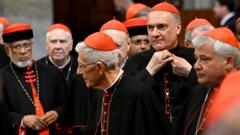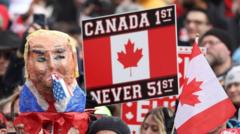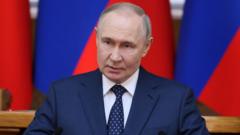In a dramatic election marked by unexpected twists, Canadians are set to determine their next leader amid economic uncertainty and international tensions. With the vote targeting Prime Minister Mark Carney’s Liberal Party and the Conservative challenger Pierre Poilievre, citizens are faced with contrasting solutions for significant national challenges.
**Canada on Edge as Trade Turmoil Shadows Election Day**

**Canada on Edge as Trade Turmoil Shadows Election Day**
As Canadians cast their votes, the looming threat of President Trump's tariffs and a changing political landscape raise crucial questions for the nation's future.
Canadians have begun to cast their ballots in a pivotal election that could reshape the nation's political landscape in the wake of President Trump's trade threats. As voters head to the polling stations, the Liberal Party, now led by Prime Minister Mark Carney, is grappling with a surprising turnaround in fortunes following the resignation of former Prime Minister Justin Trudeau earlier this year.
Months ago, the Conservatives dominated the polls, leading by over 25 percentage points with Pierre Poilievre positioned as the expected frontrunner. However, the dynamics shifted as Carney emerged as a viable candidate to combat Trump's tariffs and economic pressures on Canadian industry. With three smaller parties, including the New Democrats, the Green Party, and Bloc Quebecois also competing, the race has become increasingly complicated for both major parties.
Carney, a seasoned former central banker, has positioned himself as a stabilizing force against Trump's antagonism, arguing that his expertise could protect Canada from economic fallout. Poilievre, on the other hand, champions a vision of less governmental regulation and a reduced federal footprint, despite facing criticism for his parallels with Trump's policies.
As election day unfolds, Canadians are concerned about the economic implications of the U.S. president's threats to annex Canada as the "51st state." Trade and economic stability are at the forefront of voters' minds, compounded by rising inflation and manufacturing challenges due to U.S. tariffs. Canadians are looking for strong leadership to navigate through this critical juncture.
Canada's electoral system enables voters to select their representatives for 343 parliamentary seats, with results expected to come in late Monday night. As polls close, uncertainty looms regarding which party will emerge victorious and how they plan to reconcile with the pressing economic issues and a potentially hostile U.S. administration demanding concessions.






















